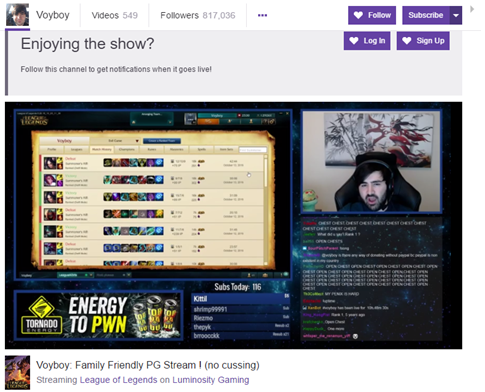[sg_popup id=”50″ event=”onload”][/sg_popup]
Last time we talked about a new realm of video gaming called streaming, and explored why we stream and what we like about it.
Today, we’re discussing the other side of livestreaming: the audience or video game viewers.
- Why do we like to spend hours and hours watching livestreams?
- What makes us do it in the first place, and what makes us continue to watch?
Twitch, the main platform for video games viewers where people broadcast and view live streams, is different than any other platform such as Youtube, or any other online game community. It makes a huge effort at taking the participatory aspects to the next level, having interactions happening in real time. In addition, we do not need to have any previous skills or knowledge to participate in Twitch, and we can decide to come and go as we please.

There are different motivations for which video game viewers watch, follow and subscribe to streaming channels. Recently a study1 found that this are the five factors that most significantly affect to that:
- get information and knowledge
- have a pleasant experience
- gain more confidence and credibility
- connect with family and friends
- have an escape or diversion from real life
More specifically, it was found that the want to have an escape or diversion from real life was the strongest positive predictor of how much time video games viewers spent watching, as well as the number of streamers watched and followed. Furthermore, in terms of predicting subscription to a streamer, which often costs money, the social aspect of forming connections seemed to play the most important role.
Another study2 examined what is unique about Twitch and what pushes people to watch. They found that most viewers first got into watching live streaming because they wanted to learn. However, what made them decide to stay was based on the streamer’s attitude and the friendliness of the community. They highlighted that Twitch is a form of a third place which is the concept of a place that’s regular, voluntary, informal, and highly anticipated by people, but it is not one’s home or work3.
Livestreams form an open community where viewers are encouraged by regular viewers and the streamer, to interact and participate in amusing and entertaining conversations. While learning about the game is an added bonus, many video games viewers also enjoyed that streams had people whom they identified and formed many emotional connections with.
Viewers also like that many streamers give them influence on the stream through polls, the opportunity to play against each other, and sharing fan art. Some favourite moments viewers in their study pointed out, were being able to see something surprising in a game that they won’t be able to see again, and seeing the reactions of the streamer in real time. All of these mentioned characteristics of Twitch are what makes people love and want to continue to watch live streams.
As a follower of several gaming channels I wonder what is the influence of all of what we have discussed in the eSports world. But this is a thing we will discuss in a next Post.
In the meantime, sounds to me like watching streams in platforms like Twitch is a fun way to pass time, meet new friends, and gain some new gaming skills, isn’t it?
But don’t worry, if video games aren’t your thing to watch, Twitch has got you covered with other real time live streams: from people cooking to playing music or programming. Streams for all tastes!
References:
1 Sjöblom, M., & Hamari, J. (2016). Why do people watch others play video games? An empirical study on the motivations of Twitch users. SSRN.
2 Hamilton, William A., Oliver Garretson, and Andruid Kerne. “Streaming on Twitch: Fostering Participatory Communities of Play within Live Mixed Media.” Proceedings of the 32nd Annual ACM Conference on Human Factors in Computing Systems – CHI ’14 (2014): n. pag. Web. 6 Oct. 2016.
3 Oldenburg, R. The great good place: Cafes, coffee shops, bookstores, bars, hair salons, and other hangouts at the heart of a community. Da Capo Press, 1997.

